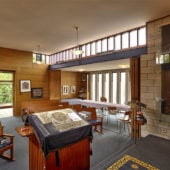The southern-most permanent synagogue in the world.
Dunedin, on New Zealand’s South Island, was a thriving whaling and trading port in the early 1800s. The Otago Gold Rush of 1861 and the West Coast Gold Rush of 1864 brought enormous growth and prosperity. To this day, wonderfully well-preserved Georgian and Victorian era buildings are found throughout the city.
Dunedin’s first synagogue opened in 1863. Eighteen years later, the Jewish community’s growth necessitated its replacement. A grand neo-classic synagogue with seating for 600 was built on Moray Place. Designed by W.H. Sumner, the fine old building is still used today as an art gallery.
Just as in Butte, Montana, the gold played out, commerce declined and predictably, the Jewish community of Dunedin dwindled. In 1965, the oversized Doric-columned Moray Place synagogue was sold to the Y.M.C.A. It was replaced with a compact synagogue of contemporary design in the city’s verdant University District. The current synagogue was designed by John Goldwater, a Jewish New Zealander, whose design projects include the Auckland, New Zealand Jewish Community Center.
There are now only a few dozen Jewish families within a hundred miles. These Jewish southern New Zealanders travel the many miles to Dunedin to participate in the Synagogue’s services and functions.





